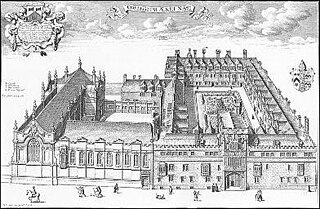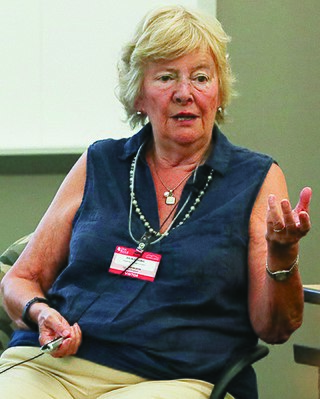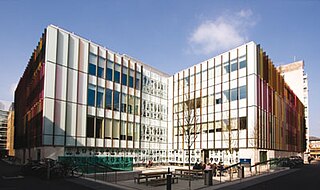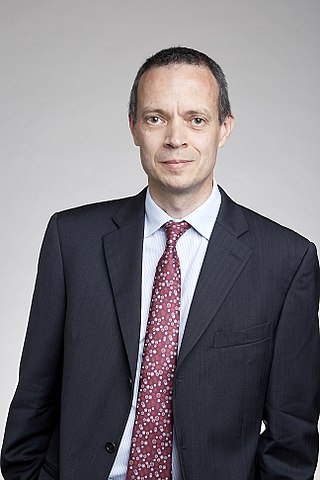Related Research Articles

Linacre College is a constituent college of the University of Oxford in the UK whose members comprise approximately 50 fellows and 550 postgraduate students.

Dudley Robert Herschbach is an American chemist at Harvard University. He won the 1986 Nobel Prize in Chemistry jointly with Yuan T. Lee and John C. Polanyi "for their contributions concerning the dynamics of chemical elementary processes". Herschbach and Lee specifically worked with molecular beams, performing crossed molecular beam experiments that enabled a detailed molecular-level understanding of many elementary reaction processes. Herschbach is a member of the Board of Sponsors of the Bulletin of the Atomic Scientists.

The University of Oxford has thirty-nine colleges, and four permanent private halls (PPHs) of religious foundation. Colleges and PPHs are autonomous self-governing corporations within the university. These colleges are not only houses of residence, but have substantial responsibility for teaching undergraduate students. Generally tutorials and classes are the responsibility of colleges, while lectures, examinations, laboratories, and the central library are run by the university. Students normally have most of their tutorials in their own college, but often have a couple of modules taught at other colleges or even at faculties and departments. Most colleges take both graduates and undergraduates, but several are for graduates only.

Jean-Marie Lehn is a French chemist. He received the Nobel Prize in Chemistry together with Donald Cram and Charles Pedersen in 1987 for his synthesis of cryptands. Lehn was an early innovator in the field of supramolecular chemistry, i.e., the chemistry of host–guest molecular assemblies created by intermolecular interactions, and continues to innovate in this field. He described the process by which molecules recognize each other. Drugs, for example, "know" which cell to destroy and which to let live. As of January 2006, his group has published 790 peer-reviewed articles in chemistry literature.

Dame Julia Stretton Higgins is a British polymer scientist. Since 1976 she has been based at the Department of Chemical Engineering at Imperial College London, where she is emeritus professor and senior research investigator.

The Department of Materials at the University of Oxford, England was founded in the 1950s as the Department of Metallurgy, by William Hume-Rothery, who was a reader in Oxford's Department of Inorganic Chemistry. It is part of the university's Mathematical, Physical and Life Sciences Division

The Department of Biochemistry of Oxford University is located in the Science Area in Oxford, England. It is one of the largest biochemistry departments in Europe. The Biochemistry Department is part of the University of Oxford's Medical Sciences Division, the largest of the university's four academic divisions, which has been ranked first in the world for biomedicine.

Dame Angela Ruth McLean is professor of mathematical biology in the Department of Biology, University of Oxford, and Chief Scientific Adviser to the UK Government.
The various academic faculties, departments, and institutes of the University of Oxford are organised into four divisions, each with its own Head and elected board. They are the Humanities Division; the Social Sciences Division; the Mathematical, Physical and Life Sciences Division; and the Medical Sciences Division.

Iain Donald Campbell was a Scottish biophysicist and academic. He was Professor of Structural Biology at the University of Oxford from 1992 to 2009.

Benjamin Guy Davis is Professor of Chemical biology in the Department of Pharmacology and a member of the Faculty in the Department of Chemistry at the University of Oxford and a Fellow of Pembroke College, Oxford. He holds the role of Science Director for Next Generation Chemistry (2019-2024) and Deputy (2020-) and Interim Director at the Rosalind Franklin Institute.

The Department of Chemistry is the chemistry department of the University of Oxford, England, which is part of the university's Mathematical, Physical and Life Sciences Division

(Edith) Yvonne JonesFLSW is director of the Cancer Research UK Receptor Structure Research Group at the University of Oxford and a Fellow of Jesus College, Oxford. She is widely known for her research on the molecular biology of cell surface receptors and signalling complexes.

Andrew John Orr-Ewing is a British chemist and Professor of physical chemistry at the University of Bristol. His work investigates the mechanisms of chemical reaction in both the gas and liquid phases and has used ultrafast laser spectroscopy to observe the effects of solvents on molecular reaction and the dynamics of photodissociation.
The Pixel Imaging Mass Spectrometry camera (PImMS) is an ultrafast imaging sensor designed for time-of-flight particle imaging. It was invented by professors of chemistry at the University of Oxford, Mark Brouard and Claire Vallance., Renato Turchetta from IMASENIC, and Andrei Nomerotski from Brookhaven National Labs. The camera and accompanying software have been further developed by Iain Sedgwick, Jaya John John, and Jason Lee. The camera has been used for studies in chemical reaction dynamics, imaging mass spectrometry, and neutron time-of-flight imaging.
Claire Vallance is a professor of Physical Chemistry at the University of Oxford, Tutorial Fellow in Physical Chemistry at Hertford College, and past President of the Faraday Division of the Royal Society of Chemistry. In collaboration with professor Mark Brouard and others, she created the PImMS sensor, used for time-of-flight particle imaging and recently featured in the Royal Society of Chemistry's Research Frontiers report. She is co-founder of the spin-out company Oxford HighQ, which is developing next-generation chemical and nanoparticle sensors based on optical microcavity technology. Vallance's research spans chemical reaction dynamics, optical microcavity spectroscopy, and applications of spectroscopy and imaging in medical diagnostics. She is also an accomplished musician and triathlete.

Ian William Murison Smith was a chemist who served as a research fellow and lecturer in the Department of Chemistry, University of Cambridge from 1963 to 1985 and Professor of Chemistry at the University of Birmingham from 1985 to 2002.
Julie Macpherson is a professor of chemistry at the University of Warwick. In 2017 she was awarded the Royal Society Innovation award for her research into boron doped diamond electrochemical sensors.
Helen H. Fielding is a Professor of physical chemistry at University College London (UCL). She focuses on ultrafast transient spectroscopy of protein chromophores and molecules. She was the first woman to win the Royal Society of Chemistry (RSC) Harrison-Meldola Memorial Prize (1996) and Marlow Award (2001).
Rachel Tanner is an immunologist working at the University of Oxford. She won the UK 'Women of the Future' Award for Science in 2019.
References
- ↑ "Professor Mark Brouard - Jesus College, University of Oxford". Jesus.ox.ac.uk. Retrieved 20 December 2017.
- ↑ "The Brouard Group - Home". Brouard.chem.ox.ac.uk. Retrieved 20 December 2017.
- ↑ "New Head of Department for Chemistry — Mathematical Physical and Life Sciences Division". Mpls.ox.ac.uk. Retrieved 20 December 2017.
- ↑ "Tutorials in Molecular Reaction Dynamics". Pubs.rsc.org. 2 December 2011. Retrieved 20 December 2017.